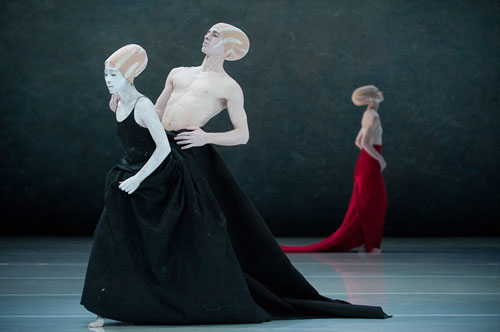Shen Wei Dance Arts

Shen Wei Dance Arts in Folding.
Photo by Christopher Duggan.
Painting With the Body
SPA Brings Shen Wei Dance Arts to Houston
Shen Wei may be best known for orchestrating the Opening Ceremonies of the 2008 Beijing Olympics, which involved 16,000 performers in the bird’s nest stadium. He’s known for creating meditative work with strong visual elements, such as abstract painting, striking lighting and minimalist costumes. Houston audiences get their first glance at Shen Wei Dance Arts (SWDA) when he lands at the Wortham Center’s Brown Theater presented by Society for the Performing Arts on May 18, with The Rite of Spring and Folding, a highly stylized piece performed to the melodies of British composer John Tavener and Tibetan Buddhist chants. A + C editor Nancy Wozny spoke with SWDA founding member James Healy, who brings us into the Shen Wei experience.
Arts + Culture: This will be the first time the company has come to Houston. What do you want the audience to know about Shen Wei’s work?
James Healy: The viewer should experience the work as if they are viewing a painting or listening to a piece of instrumental music. Shen Wei often creates work that is visually rich and beautiful, but when developing the work, he is rarely interested in handing the audience a clear emotional experience or a story.
A + C: Shen Wei uses the four -hand piano version of Stravinsky’s classic piece, arranged by the Turkish pianist and composer Fazil Say. How does this add a different flavor?
JH: This dynamic version of the Stravinsky score simplifies the sounds of a full orchestra, and expresses them through one piano. The sound is still full, intense, and beautiful, but has a very different quality than the original full orchestra version. Shen Wei wanted to show this unique music in a visual way more than anything else.
A + C: Is the score mirrored in the movement?
JH: It took nearly two years to develop a very specific movement vocabulary that mirrored the various musical qualities for each section. The goal of the dancer is to clearly express each movement quality as it relates to the sound quality that the piano creates. In order to accomplish this, the dancers isolate various body systems to give each movement its unique place within the music. Since the music is so layered and dynamic, each dancer must quickly switch from one quality of movement to another, and often several movement qualities will overlap or morph into a new movement dynamic all-together. The audience will see each dancer twist and fold into shapes as they become the sounds that Fazil Say has magically manipulated. A dancer might be moving with a silky- smooth quality one second, then all of a sudden dive across the floor with gravity and momentum the next.
A + C: How does Shen Wei’s interest in abstract painting factor into the work?
JH: The dancers perform the piece on a huge abstract painting, made up mostly of black, white, and gray shades. The dancers’ patterns, movements, and costumes reflect the strokes, swirls, and lines within the dynamic painting. All narrative traditionally connected to Rite of Spring is left behind for Shen Wei’s version, so what the audience experiences is a dynamic visual interpretation of the music.
A + C: Bring us into Folding, the other work on the program.
Folding is mostly slow, controlled, and meditative movement, where Rite of Spring is fast, vigorous, and layered.
A + C: How does Folding contrast with Rite?
JH: The costuming and colors used in Folding, as well as the use of partnering and dynamic spatial relationships, stimulates a deep emotional experience. Rite of Spring, with a strong connection to abstract art, is kinetic and dynamic, evoking a physically stimulated response, perhaps less emotional. In both Rite and Folding, Shen Wei’s connection to Chinese Opera is evident in various movement choices, and especially in the unique way the dancers run with tiny, fast footsteps that cause then to appear as though they are gliding on ice. In both pieces, the dancer stays emotionally neutral, and lets the strict and specific movement vocabulary dictate the expressive, emotional element.
A +C: Shen Wei is famous for large-scale work. What are the challenges and joys of doing this kind of work?
JH: We almost never get to rehearse with all of the elements that the piece requires. In Rite we dance on a giant piece of canvas, while in Foldingwe dance on a plastic floor. In both pieces, the ideal stage is larger than an average NYC studio space. In some pieces we paint on stage using our entire bodies, in another piece we use giant staircase that extends from one side of the stage to the other, and in another, we dance on a two-inch layer of confetti. Usually, we only get a couple hours of rehearsal and one dress rehearsal to iron out all the kinks. This is also why it’s so much fun to be a part of the process. It never gets predictable.




Recent Comments